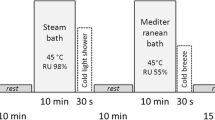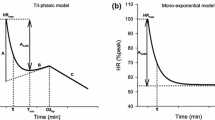Abstract
It was already established that exposure to hyperbaric conditions induces vagal-depended bradycardia but field study on autonomic nervous system (ANS) activity during self-contained underwater breathing apparatus (SCUBA) diving is lacking. The aim of the present study was to evaluate ANS modifications during real recreational SCUBA diving using heart rate variability analysis (timedomain, frequency-domain and Poincaré plot) in 10 experienced and volunteers recreational divers. Mean RR, root mean square of successive differences of interval (rMSSD), high frequency of spectral analysis and standard deviation 1 of Poincaré Plot increased (P < 0.05) during dive. Low frequency/high frequency ratio decreased during dive (P < 0.05) but increased after (P < 0.05). Recreational SCUBA diving induced a rise in vagal activity and a decrease in cardiac sympathetic activity. Conversely, sympathetic activity increases (P < 0.05) during the recovery.




Similar content being viewed by others
References
Akselrod S, Gordon D, Ubel FA, Shannon DC, Berger AC, Cohen RJ (1981) Power spectrum analysis of heart rate fluctuation: a quantitative probe of beat-to-beat cardiovascular control. Science 213(4504):220–222. doi:10.1126/science.6166045
Bonde-Petersen F, Schultz-Pedersen L, Dragsted N (1992) Peripheral and central blood flow in man during cold, thermoneutral, and hot water immersion. Aviat Space Environ Med 63(5):346–350
Brown TE, Beightol LA, Koh J, Eckberg DL (1993) Important influence of respiration on human R-R interval power spectra is largely ignored. J Appl Physiol 75(5):2310–2317
Eckenhoff RG, Knight DR (1984) Cardiac arrhythmias heart rate changes in prolonged hyperbaric air exposures. Undersea Biomed Res 11(4):355–367
Gabrielsen A, Johansen LB, Norsk P (1993) Central cardiovascular pressures during graded water immersion in humans. J Appl Physiol 75(2):581–585
Hayashi N, Ishihara M, Tanaka A, Osumi T, Yoshida T (1997) Face immersion increases vagal activity as assessed by heart rate variability. Eur J Appl Physiol Occup Physiol 76(5):394–399. doi:10.1007/s004210050267
Hirayanagi K, Nakabayashi K, Okonogi K, Ohiwa H (2003) Autonomic nervous activity and stress hormones induced by hyperbaric saturation diving. Undersea Hyperb Med 30(1):47–55
Johnson DG, Hayward JS, Jacobs TP, Collis ML, Eckerson JD, Williams RH (1977) Plasma norepinephrine responses of man in cold water. J Appl Physiol 43(2):216–220
Katona PG, Jih F (1975) Respiratory sinus arrhythmia: noninvasive measure of parasympathetic cardiac control. J Appl Physiol 39(5):801–805
Kinoshita T, Nagata S, Baba R, Kohmoto T, Iwagaki S (2006) Cold-water face immersion per se elicits cardiac parasympathetic activity. Circ J 70(6):773–776. doi:10.1253/circj.70.773
Kollai M, Mizsei G (1990) Respiratory sinus arrhythmia is a limited measure of cardiac parasympathetic control in man. J Physiol 424:329–342
Lafay V (2006) The heart and undersea diving. Arch Mal Coeur Vaiss 99(11):1115–1119
Lafay V, Boussuges A, Ambrosi P, Barthelemy P, Frances Y, Gardette B, Jammes Y (1997) Doppler-echocardiography study of cardiac function during a 36 atm (3, 650 kPa) human dive. Undersea Hyperb Med 24(2):67–71
Lemaitre F, Bernier F, Petit I, Renard N, Gardette B, Joulia F (2005) Heart rate responses during a breath-holding competition in well-trained divers. Int J Sports Med 26(6):409–413. doi:10.1055/s-2004-821159
Lund VE, Kentala E, Scheinin H, Klossner J, Helenius H, Sariola-Heinonen K, Jalonen J (1999) Heart rate variability in healthy volunteers during normobaric and hyperbaric hyperoxia. Acta Physiol Scand 167(1):29–35. doi:10.1046/j.1365-201x.1999.00581.x
Lund V, Kentala E, Scheinin H, Klossner J, Sariola-Heinonen K, Jalonen J (2000) Hyperbaric oxygen increases parasympathetic activity in professional divers. Acta Physiol Scand 170(1):39–44. doi:10.1046/j.1365-201x.2000.00761.x
Marabotti C, Belardinelli A, L’Abbate A, Scalzini A, Chiesa F, Cialoni D, Passera M, Bedini R (2008) Cardiac function during breath-hold diving in humans: an echocardiographic study. Undersea Hyperb Med 35(2):83–90
Mitchell JH, Haskell W, Snell P, Van Camp SP (2005) Task Force 8: classification of sports. J Am Coll Cardiol 45:1364–1367. doi:10.1016/j.jacc.2005.02.015
Miwa C, Sugiyama Y, Mano T, Iwase S, Matsukawa T (1996a) Spectral characteristics of heart rate and blood pressure variabilities during head-out water immersion. Environ Med 40(1):91–94
Miwa C, Mano T, Saito M, Iwase S, Matsukawa T, Sugiyama Y, Koga K (1996b) Ageing reduces sympatho-suppressive response to head-out water immersion in humans. Acta Physiol Scand 158(1):15–20. doi:10.1046/j.1365-201X.1996.527289000.x
Miwa C, Sugiyama Y, Mano T, Iwase S, Matsukawa T (1997) Sympatho-vagal responses in humans to thermoneutral head-out water immersion. Aviat Space Environ Med 68(12):1109–1114
Molénat F, Boussuges A, Grandfond A, Rostain JC, Sainty JM, Robinet C, Galland F, Meliet JL (2004) Haemodynamic effects of hyperbaric hyperoxia in healthy volunteers: an echocardiographic and Doppler study. Clin Sci (Lond) 106(4):389–395. doi:10.1042/CS20030293
Mourot L, Bouhaddi M, Gandelin E, Cappelle S, Dumoulin G, Wolf JP, Rouillon JD, Regnard J (2008) Cardiovascular autonomic control during short-term thermoneutral and cool head-out immersion. Aviat Space Environ Med 79(1):14–20. doi:10.3357/ASEM.2147.2008
Neubauer B, Tetzlaff K, Staschen CM, Bettinghausen E (2001) Cardiac output changes during hyperbaric hyperoxia. Int Arch Occup Environ Health 74(2):119–122. doi:10.1007/s004200000201
Niskanen JP, Tarvainen MP, Ranta-Aho PO, Karjalainen PA (2004) Software for advanced HRV analysis. Comput Methods Programs Biomed 76(1):73–81. doi:10.1016/j.cmpb.2004.03.004
Norsk P (1992) Gravitational stress and volume regulation. Clin Physiol 12(5):505–526. doi:10.1111/j.1475-097X.1992.tb00355.x
Norsk P, Bonde-Petersen F, Warberg J (1985) Central venous pressure and plasma arginine vasopressin during water immersion in man. Eur J Appl Physiol Occup Physiol 54(1):71–78. doi:10.1007/BF00426302
Pelliccia A, Fagard R, Bjornstad HH et al (2005) Recommendations for competitive sports participation in athletes with cardiovascular disease: a consensus document from the Study Group of Sports Cardiology of the Working Group of Cardiac Rehabilitation and Exercise Physiology and the Working Group of Myocardial and Pericardial Diseases of the European Society of Cardiology. Eur Heart J 26:1422–1445. doi:10.1093/eurheartj/ehi325
Periodtoe A, Sawada Y (1989) Assessment of baroreceptor reflex function during mental stress and relaxation. Psychophysiology 26(2):140–147. doi:10.1111/j.1469-8986.1989.tb03145.x
Portier H, Guézennec CY (2007) Study of heart rate variability during offshore race with sleep deprivation. Sci Sports 22:163–165. doi:10.1016/j.scispo.2007.05.002
Radespiel-Tröger M, Rauh R, Mahlke C, Gottschalk T, Mück-Weymann M (2003) Agreement of two different methods for measurement of heart rate variability. Clin Auton Res 13(2):99–102. doi:10.1007/s10286-003-0085-7
Ross A, Periodtoe A (1980) Attenuation of the diving reflex in man by mental stimulation. J Physiol 302:387–393
Schipke JD, Pelzer M (2001) Effect of immersion, submersion, and scuba diving on heart rate variability. Br J Sports Med 35(3):174–180. doi:10.1136/bjsm.35.3.174
Shiraishi M, Schou M, Gybel M, Christensen NJ, Norsk P (2002) Comparison of acute cardiovascular responses to water immersion and head-down tilt in humans. J Appl Physiol 92(1):264–268
Srámek P, Simecková M, Janský L, Savlíková J, Vybíral S (2000) Human physiological responses to immersion into water of different temperatures. Eur J Appl Physiol 81(5):436–442. doi:10.1007/s004210050065
Task Force of the European Society of Cardiology, the North American Society of Pacing, Electrophysiology (1996) Heart rate variability: standards of measurement, physiological interpretation and clinical use. Circulation 93(5):1043–1065
Tulppo MP, Mäkikallio TH, Takala TE, Seppänen T, Huikuri HV (1996) Quantitative beat-to-beat analysis of heart rate dynamics during exercise. Am J Physiol 271(1 Pt 2):H244–H252
Ueno LM, Miyachi M, Matsui T, Takahashi K, Yamazaki K, Hayashi K, Onodera S, Moritani T (2005) Effect of aging on carotid artery stiffness and baroreflex sensitivity during head-out water immersion in man. Braz J Med Biol Res 38(4):629–637. doi:10.1590/S0100-879X2005000400018
Author information
Authors and Affiliations
Corresponding author
Rights and permissions
About this article
Cite this article
Chouchou, F., Pichot, V., Garet, M. et al. Dominance in cardiac parasympathetic activity during real recreational SCUBA diving. Eur J Appl Physiol 106, 345–352 (2009). https://doi.org/10.1007/s00421-009-1010-0
Accepted:
Published:
Issue Date:
DOI: https://doi.org/10.1007/s00421-009-1010-0




